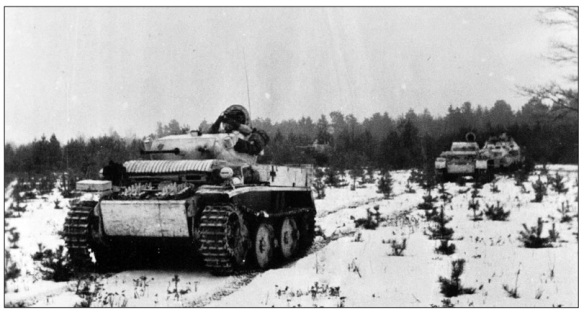The first trial vehicle was completed in April 1942.
The Luchs (Lynx) was developed as a fully-tracked armoured reconnaissance vehicle. The development order was issued on 15 April 1939, with production to begin in August 1942. MAN developed the chassis and Daimler-Benz, the superstructure and turret. The first trial vehicle was completed in April 1942. The initial order was for 800 Luchs, the first 100 with the 2cm KwK38 and the remainder with the 5cm KwK 39/1 L/60 (designated Leopard). However, the Scm KwK 39/1 version was never produced, because an order issued in January 1943 decreed that production cease after the first 100 Luchs had been completed.
The VK1303 retained the same suspension and hull design as its predecessor, the VK901. The superstructure was widened, extending over the tracks to allow a larger turret to be mounted. The turret lacked a cupola and vision ports. In their place, two revolving periscopes were fitted to the turret roof to provide vision for the gunner and commander.
9. Panzer Divison Service
In April 1943 a company of Armoured Reconnaissance Vehicles “b” (Panzer-Spähwagen-Kompanie “b” (Pz.Spah.Kp. “b”)) to the 9thArmoured Reconnaissance Battalion. The company was equipped with the reconnaissance tanks designated as Panzerspähwagen II Ausf. L (Sd.Kfz. 123) “Luchs“ (“Lynx”).
According to the original plan, the company was to become the 5th Company of the 9th Armoured Reconnaissance Battalion, but later this designation was changed to the 2nd Company. The Armoured Reconnaissance Vehicles Company “b” was established according to the order issued on February 23 1943. It was the first Wehrmacht unit to be equipped with the “Luchs” tanks. The company had 18 tanks of this type. Formation of the unit took place in France; its combat readiness was attained on March 25 1943. 57 At first, it was intended to join the 10th Panzer Division,58 or according to other sources the 9th SS Panzer Grenadiers Division (9. SS-Pz. Gren.Div.).59 At the beginning of April 1943, it was decided that the “Luchs” company would be assigned to the 9th Panzer Division. The official identifier of this sub-unit from April 30 was the 2nd Panzer Reconnaissance Company of the 9th Panzer Reconnaissance Battalion (2. Panzer-Späh-Kompanie/Pz.Aufkl.Abt. 9).60 On April 26, the company was dispatched from France to Germany so it could join the rest of the recently formed reconnaissance battalion. An order dated May 4 requested the transfer of the 9th Armoured Reconnaissance Battalion, including the newly formed Pz.Spah.Kp. “b”, from Bruck an der Leitha to Army Group “South” to commence on May 11. As the battalion reached Orel, it was most likely reinforced with the remainder of the 59th Motorcycle Rifle Battalion.
Apart from the “Luchs” company, the 9th Armoured Reconnaissance Battalion had two reconnaissance companies equipped with half-tracked armoured transporters Sd.Kfz. 250, a reconnaissance platoon with Schwimmwagen amphibious all-terrain cars, and some heavy self-propelled anti-tank guns, most likely of sPak. (Sfl) “Marder” type. As of June 1943, the 2nd Company of the 9th Armoured Reconnaissance Battalion had at its disposal 29 “Luchs” tanks and four armoured transporters Sd.Kfz. 251/1.
The Panzerspähwagen II Ausf. L “Luchs” earned a favourable rating. In a report from August 1943 Feldwebel Weber, one of the “Luchs” drivers, wrote about his experiences while serving with the 2nd Reconnaissance Tank Company of the 9th Panzer Reconnaissance Battalion: “During my exposure to the Luchs, I did not notice any sign of technical difficulties, with the exception of minor issues with the steering mechanism. The tank has superb manoeuvrability and mobility. High speed and small dimensions make this vehicle a very hard target for the enemy.”
By August 17, the company had only five operational “Luchs” tanks.
Manufacturer: MAN
Chassis Nos.: 200101-200200
100 produced from September 1943 to January 1944 plus 4 converted from VK1301
